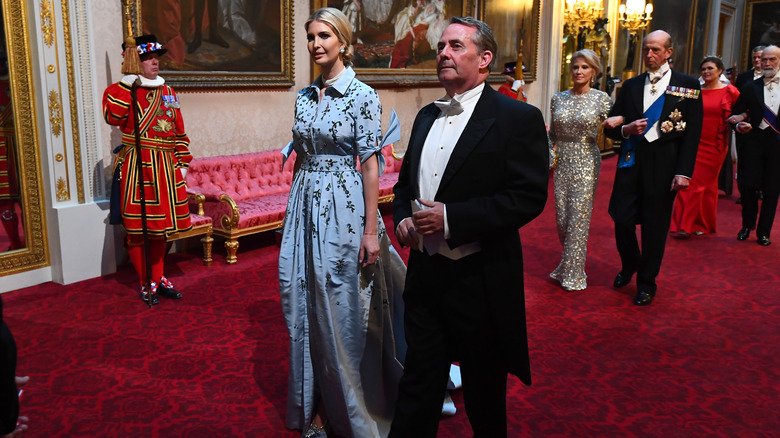The world of royalty thrives on symbolism. Sometimes it’s a gown. Sometimes it’s a glance. And sometimes it’s something as simple as a handshake.
On September 14, 2025, inside a discreet salon at Kensington Palace, history quietly tilted on its axis. Three women—Ivanka Trump, former First Daughter; Melania Trump, America’s elegant First Lady; and Catherine, Princess of Wales—sat shoulder-to-shoulder for an intimate discussion on women’s empowerment. It was meant to be a prelude to Donald Trump’s much-anticipated state visit three days later. Instead, it became the preamble to something far more electrifying: King Charles himself, arriving unannounced, extended a handshake to Ivanka Trump in front of the watching world.
For a monarchy bound by centuries of protocol, this was no small moment. It was a signal—warm, deliberate, and disruptive. And as Queen Camila lingered on the edges, observers could not help but wonder: was this a glimpse of the crown’s future alliances, or simply a fleeting break from tradition?
A Trio of Unexpected Power
The stage had been set with months of quiet planning. Melania Trump was in London to prepare for the state visit. Ivanka, no longer an official political figure but still a woman of formidable influence, decided to accompany her mother. And Catherine, Princess of Wales—recovering from health challenges yet radiant as ever—was chosen as the host.
The gathering was billed as a round-table on women’s philanthropy: child welfare, entrepreneurship, and education. Guests included select philanthropists and charity leaders. Catherine wore a soft blue midi dress by one of her favorite sustainable designers. Melania, poised in tailored navy, embodied diplomatic grace. Ivanka, in a crisp white blouse and pencil skirt, projected the savvy of a businesswoman.
The chemistry between the three was immediate. They laughed about the pressures of motherhood under scrutiny. They traded stories about mentoring young women. Catherine spoke of her “Shaping Us” campaign. Melania shared her “Be Best” initiative. Ivanka spoke with passion about global programs training women in STEM.
“It was like watching three powerhouses sync in real time,” one charity director later recalled.
The Moment Charles Walked In
As the discussion warmed, the door opened and King Charles entered. The room stilled. His presence had not been announced. His appearance, palace aides later admitted, was a last-minute decision—his way of welcoming the Trumps ahead of the official visit.
Charles first greeted Catherine with fatherly warmth, then Melania with a bow and a compliment on her travels. But then, in a move that stunned even seasoned palace watchers, he extended his hand to Ivanka Trump.
“Miss Trump, your insights on global trade are most welcome. We must collaborate more,” the king said, his grip firm, his tone deliberate.
Ivanka smiled, returning the gesture with calm assurance: “It is an honor, Your Majesty. Britain’s innovation has always inspired me.”
The handshake lasted just twenty seconds. Yet in those seconds, it broke through centuries of rigid royal etiquette. For the sovereign to offer such warmth to someone outside official state office—a private citizen—was almost unheard of.
A Queen on the Sidelines
While the room buzzed with whispers about the gesture, another moment quietly unfolded: Queen Camila entered late, dressed in emerald, her smile warm but her position unmistakably peripheral.
She mingled gracefully, spoke of her literary charities, and exchanged pleasantries with guests. But the core circle had already formed—Catherine, Melania, Ivanka, and now King Charles at its center. Camila, ever gracious, seemed on the margins.
Observers noted the optics: three glamorous women embodying fresh influence, while the queen consort—steady, dutiful, but older—stood slightly apart. It was not intentional snubbing. It was timing. Yet in the world of monarchy, optics are everything.
Why It Matters
This was not the first time the Trumps brushed with royalty. In 2019, Donald and Melania visited Queen Elizabeth II in a visit marred by awkward optics and public protests. Ivanka posed for photographs that sparked debates on protocol.
But 2025 is different. Donald Trump is back in the White House. Charles has settled into his reign. Relations between Washington and London carry a renewed urgency in a post-Brexit, shifting world. Against that backdrop, a warm royal handshake to Ivanka Trump was a diplomatic thunderclap.
Analysts immediately dissected the gesture. Was Charles signaling personal respect for Ivanka’s philanthropic work? Or was he, ever the pragmatist, building bridges with the family that currently holds sway in Washington?
Catherine at the Center
Lost amid the viral clip of the handshake was the woman who had made the moment possible. Catherine’s quiet hosting, her grace in weaving American boldness with British reserve, set the tone.
It is Catherine who has become the monarchy’s emotional core in recent years—navigating health struggles, holding her family together, and modernizing royal engagements. Her warmth with Melania, her rapport with Ivanka, and her ability to make King Charles’s surprise entrance flow seamlessly all underscored her role as the monarchy’s anchor.
The Ripples
By the next morning, hashtags like #RoyalHandshake trended worldwide. Tabloids splashed photographs of Charles and Ivanka across front pages. American networks debated the meaning. Was it flattery? Strategy? Or both?
SCROLL DOWN TO CONTINUE
For Ivanka, it marked a return to the public eye with royal validation. For Melania, it was proof her quiet diplomacy still holds weight. For Catherine, it was yet another moment confirming her as the face of the monarchy’s future. And for Queen Camila, it was a reminder of shifting tides.
A Crown in Transition
What does it all mean for the monarchy? Perhaps nothing more than a gesture of courtesy. Or perhaps everything.
A king, extending his hand to a figure outside the rigid confines of statecraft. A queen consort on the periphery. A princess seamlessly uniting worlds.
It may be remembered not as a break in tradition, but as a symbol of adaptation. Proof that the British crown—steeped in centuries of custom—still knows how to evolve in a world where alliances are as likely to be forged over philanthropy and shared causes as they are across treaty tables.




